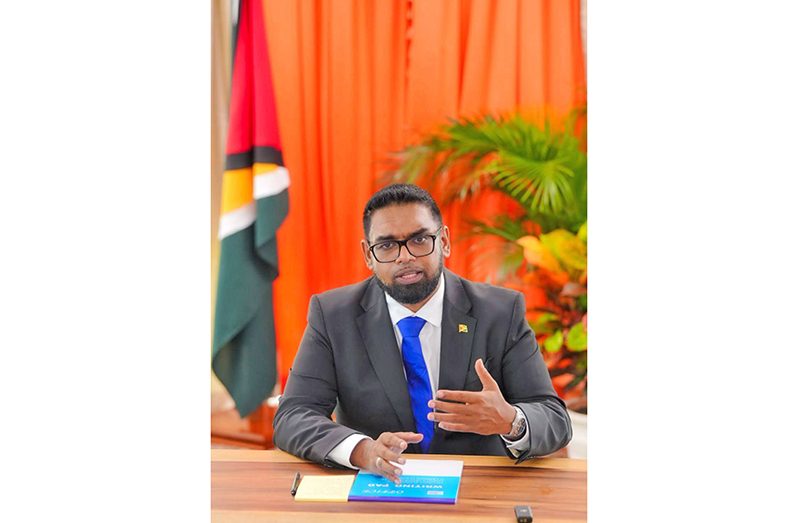–to create opportunities for its people, President Ali affirms
AS Guyana moves forward with its ambitious plans to tap into its lucrative oil-and-gas reserves, President, Dr Irfaan Ali has reaffirmed that the balancing act between economic growth and environmental stewardship remains at the forefront of the nation’s agenda
During a recent interview with the BBC’s HARDtalk, President Ali found himself defending this stance, again.
Host Stephen Sackur questioned President Ali on whether Guyana’s focus on fossil-fuel extraction contradicts global efforts to combat climate change.
Sackur attempted to lecture the Head of State on climate change, highlighting the potential environmental impact of extracting $150 billion worth of oil-and-gas reserves off Guyana’s coast, pointing to the release of more carbon emissions into the atmosphere.
Responding firmly, President Ali said: “Let me stop you right there. Do you know that Guyana has a forest, forever[sic], that is the size of England and Scotland combined? A forest that stores 19.5 gigatons of carbon? A forest that we have kept alive?”
Sackur further pressed President Ali on whether Guyana’s preservation of its vast forest, which stores a significant amount of carbon, justifies the decision to release carbon emissions through oil and gas extraction.
However, President Ali strategically flipped the script and put the question to the host: “Does that give you the right to lecture us on climate change?” adding: “I am going to lecture you on climate change.”
In challenging critics’ authority to criticise Guyana’s actions, President Ali highlighted Guyana’s environmental stewardship which he said justifies its pursuit of oil-and-gas development, while maintaining a net-zero carbon footprint.
Sackur further questioned Guyana’s approach, referencing comments from Vice-President, Dr Bharrat Jagdeo expressing the urgency to extract oil amid the climate change imperative.
President Ali defended this stance as “practical” and “honest,” asserting Guyana’s commitment to economic development and creating opportunities for its people.
He emphasised the country’s need to aggressively pursue its natural resources for economic growth and development, highlighting the lack of external support in bringing opportunities to Guyana.
“You can say we are rushing, but we are very practical. We have this natural resource. And we’re going to aggressively pursue this natural resource because we have to develop our country.
“We are committed to the development of this region. We have to create opportunities for our people because no one is bringing it out for us,” President Ali said.
The international community has long praised Guyana for its dedication to environmental sustainability and leadership in addressing climate change.
Recently, Ambassador Linda Thomas-Greenfield, the US envoy to the United Nations, acknowledged President Ali’s dedication to environmental priorities, particularly in supporting rural communities and maintaining forest cover.
Meanwhile, the World Bank’s Vice-President for the Latin America and Caribbean Region, Carlos Felipe Jaramillo, has said that the international financial institution is interested in the good learning practices that Guyana has to offer in its efforts to combat the effects of climate change.
Guyana’s commitment is evident in the initiatives aimed at combatting climate change and enhancing economic resilience within the Caribbean Community (CARICOM), as it contributed US$2 million to the Regional Adaptation Fund.
Guyana is also making strides in biodiversity conservation by setting up a state-of-the-art biodiversity centre, as part of its Low Carbon Development Strategy (LCDS) 2030. This strategy aims to balance economic growth with environmental preservation.
Guyana’s historic $1.146 trillion 2024 budget, is also set to transform the country’s economic landscape.

RELIABLE AND ALTERNATIVE ENERGY
Major projects such as the gas-to-energy initiative and the Amaila Falls Hydro Project are underway, aiming to provide affordable, reliable energy while reducing reliance on fossil fuels.
Some of the other alternative energy sources that Guyana is investing in include biomass and bagasse-based cogeneration, rice husk, biodiesel, ethanol and wind.
Those investments align with Guyana’s goal to transition to renewable energy sources and reduce its greenhouse gas emissions.
The country aims to achieve a 75 per cent renewable energy consumption by 2030, as outlined in the LCDS.
Additionally, the country is making significant progress in renewable energy, with a focus on solar projects expected to provide power to nearly 90 per cent of the hinterland population by 2025. These efforts align with global sustainability goals and support inclusive growth and energy access.
The government is also taking regional leadership through initiatives such as the ‘25 by 25’ plan, aimed at reducing CARICOM’s food-import bill by 25% by 2025 and forging innovative financing models for environmental sustainability, such as the landmark agreement with Hess Corporation for the purchase of 2.5 million carbon credits annually.
Economic forecasts for Guyana are exceptionally positive, with the World Bank predicting unparalleled growth rates in the coming years, driven by oil production and the diversification of sectors such as agriculture and construction.
The forecast predicts an astounding 38.2 per cent growth in 2024 and 15.2 per cent in 2025 for Guyana, the highest in the Caribbean. Overall, the country’s economic landscape is set for continued expansion, with growth averaging 20 per cent annually from 2024 to 2028.
This growth is supported by an ambitious budget focused on development, infrastructure, and social welfare, without new taxes. However, the spectre of climate change and environmental degradation looms large.
Guyana is addressing these challenges head-on, with comprehensive strategies for low-carbon development and significant investments in renewable energy projects, including solar, hydropower, and wind initiatives.
The country’s transition to cleaner energy sources is also reflected in the development of infrastructure such as the Corentyne River Bridge, enhancing connectivity and trade potential.
In preparation for the future, Guyana is enhancing its safety and environmental protection measures, particularly in the oil sector, with a National Oil Spill Response Plan and regular training exercises.
This proactive stance ensures that while the country harnesses its natural resources for economic gain, it remains vigilant against potential environmental risks.




.png)









